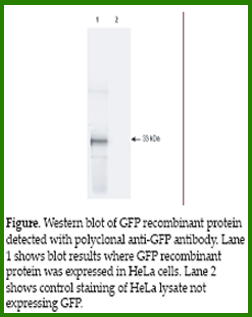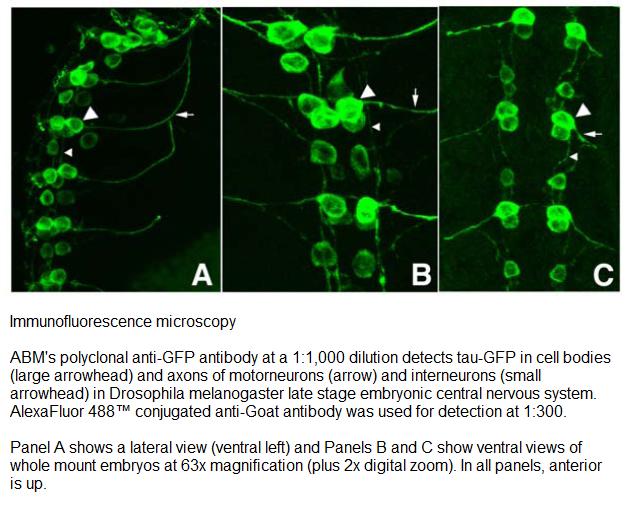Anti-GFP Tag Antibody (Goat Polyclonal)
|
Cat. No.
|
G095
Print
|
|
Name
|
Anti-GFP Tag Antibody (Goat Polyclonal)
|
|
Unit
|
100 μg
|
|
Clone
|
N/A
|
|
Category
|
Tag Antibodies
|
|
Application
|
WB,IHC,ELISA,IP,ICC/IF
|
|
Raised In
|
Goat
|
|
Clonality
|
Tag
|
|
Reactivity
|
Other
|
|
Immunogen
|
The anti-GFP immunogen is a Green Fluorescent Protein (GFP) fusion protein corresponding to the full length amino acid sequence (246aa) derived from the jellyfish Aequorea victoria.
|
|
Isotype
|
IgG
|
|
Concentration
|
100ug/100ul
|
|
Recommended Dilutions
|
ELISA 1:40,000; WESTERN BLOT 1:400 - 1:2,000; IMMUNOHISTOCHEMISTRY 1:200 - 1:1,000; IF MICROSCOPY 1:1,000; IP 1:200
|
|
Storage Buffer
|
PBS, pH 7.4 with 0.05% sodium azide.
|
|
Storage Condition
|
This product is stable for several weeks at 4° C as an undiluted liquid. Dilute only prior to immediate use. For extended storage, aliquot contents and freeze at -20° C or below. Avoid cycles of freezing and thawing. Expiration date is one (1) year from date of receipt.
|
|
Formulation
|
Liquid
|
|
Specificity
|
Recognize GFP and its variants.
|
|
Purity
|
This product was prepared from monospecific antiserum by immunoaffinity chromatography using Green Fluorescent Protein (Aequorea victoria) coupled to agarose beads followed by solid phase adsorption(s) to remove any unwanted reactivities. Assay by immunoelectrophoresis resulted in a single precipitin arc against anti-Goat Serum and purified and partially purified Green Fluorescent Protein (Aequorea victoria). No reaction was observed against Human, Mouse or Rat serum proteins.
|
|
Guarantee
|
abm guarantees that all our Anti-GFP Tag Antibody (Goat Polyclonal) will perform as described on this product webpage, if this is not the case we will provide you with a one-time replacement at no extra cost. Documentation and explanation of experiment conducted will be required when submitting a claim for replacement.
|
|
Material Citation
|
If use of this material results in a scientific publication, please cite the material in the following manner: Applied Biological Materials Inc, Cat. No. G095
|
There are no Documents for this product yet!
There are no FAQs for this product yet!
-
Sutton, LM et al. "Hip14l-deficient mice develop neuropathological and behavioural features of Huntington disease" Hum Mol Genet 22 (3):452-465 (2013). DOI: 10.1093/hmg/dds441. Application: Immunoprecipitation.
-
Luchniak, A et al. "Structure-function analysis of yeast" Methods Cell Biol 115:355-374 (2013). DOI: 10.1016/B978-0-12-407757-7.00022-0. Application: SDS-PAGE.
This product has no review yet.
Log in
to submit a review with a staining image and receive a $10 Starbucks Gift card!
{"id":65835,"cat_no":"G095","old_cat_no":"G095","name":"Anti-GFP Tag Antibody (Goat Polyclonal)","category_id":54,"category_name":"Tag Antibodies","frontend_category_id":8,"frontend_category_ids":"86,1,7,8","gene_id":0,"gene_name":"","gene_full_name":"","alias":"","unit_quantity":"100 \u03bcg","accession_number":"","species_id":0,"species":"","application_id":"1,2,3,4,5","application":"WB,IHC,ELISA,IP,ICC\/IF","raised_in_id":5,"raised_in":"Goat","clonality_id":3,"clonality":"Tag","antibody_type_id":0,"antibody_type":"","tissue_id":0,"tissue":"","reactivity_id":"22","reactivity":"Other","price":"320.0000","price_before_discount":"0.0000","keywords":"0","invisible_search_keywords":"CFP GFP RFP YFP tag","filter_group_id":22,"filter_group_name":"Antibodies","filter_id":25,"filter_name":"Tag antibodies","search_filter_ids":"58,60","search_filter_keys":"58-60","temp_field":null,"customization":0,"filter_table_id":0,"filter_table_name":"","points_rule":7,"related_group_id":0,"url":"","operator":"","status":1,"need_remove":0,"document_sort":"","price_old":"295.0000","price2024":"310.0000","created_at":"2022-09-22 02:58:35","updated_at":"2025-01-06 10:08:12","Confirmed":"Need Confirm","geo_price_before_discount":"0.00","geo_titer7_price_before_discount":"149.00","cate_url":"Tag-Antibodies.html","frontendBreadcrumbs":[{"id":1,"pid":86,"name":"General Materials","page_id":27,"page_type":"App\\Models\\Category","href":null,"sort":1,"show_in_nav":1,"show_in_homepage":1,"has_children":1,"status":1,"related_table":null,"created_at":null,"updated_at":null,"url_key":"general-materials.html","url":"general-materials.html"},{"id":7,"pid":1,"name":"Antibodies","page_id":23,"page_type":"App\\Models\\Category","href":null,"sort":7,"show_in_nav":1,"show_in_homepage":1,"has_children":1,"status":1,"related_table":null,"created_at":null,"updated_at":null,"url_key":"antibodies.html","url":"antibodies.html"},{"id":8,"pid":7,"name":"Tag Antibodies","page_id":54,"page_type":"App\\Models\\Category","href":null,"sort":8,"show_in_nav":1,"show_in_homepage":1,"has_children":0,"status":1,"related_table":null,"created_at":null,"updated_at":null,"url_key":"Tag-Antibodies.html","url":"Tag-Antibodies.html"}],"price_flag":0,"builderURL":"","builderViewerURL":"","mapURL":"","viewerURL":"","builderType":"","productType":"App\\Models\\CatalogBaseAntibody","geo_price":"320.00","geo_price_symbol":"$320.00","category":{"id":54,"categories":"Tag Antibodies","pid":23,"url_key":"Tag-Antibodies.html","css":"\/assets\/css\/abm.other.css,\/assets\/css\/abm.categorys.css,\/assets\/css\/abm.table.css","wid":0,"breadcrumbs":"[{\u0022url\u0022:\u0022https:\/\/www.abmgood.com\/\u0022,\u0022title\u0022:\u0022Home\u0022},{\u0022url\u0022:\u0022https:\/\/www.abmgood.com\/antibodies.html\u0022,\u0022title\u0022:\u0022Antibodies\u0022},{\u0022url\u0022:\u0022https:\/\/www.abmgood.com\/Tag-Antibodies.html\u0022,\u0022title\u0022:\u0022Tag Antibodies\u0022}]","breadcrumbsIdJson":"\u003Cscript type=\u0022application\/ld+json\u0022\u003E{\u0022@context\u0022:\u0022https:\/\/schema.org\u0022,\u0022@type\u0022:\u0022BreadcrumbList\u0022,\u0022itemListElement\u0022:[{\u0022@type\u0022:\u0022ListItem\u0022,\u0022position\u0022:1,\u0022name\u0022:\u0022Home\u0022,\u0022item\u0022:\u0022https:\/\/www.abmgood.com\/\u0022},{\u0022@type\u0022:\u0022ListItem\u0022,\u0022position\u0022:2,\u0022name\u0022:\u0022Antibodies\u0022,\u0022item\u0022:\u0022https:\/\/www.abmgood.com\/antibodies.html\u0022},{\u0022@type\u0022:\u0022ListItem\u0022,\u0022position\u0022:3,\u0022name\u0022:\u0022Tag Antibodies\u0022}]}\u003C\/script\u003E","breadcrumbsHtml":"\u003Cul class=\u0022abm-breadcrumb\u0022\u003E\u003Cli\u003E\u003Ca href=\u0022https:\/\/www.abmgood.com\/\u0022\u003EHome\u003C\/a\u003E\u003C\/li\u003E\u003Cli\u003E\u003Ca href=\u0022https:\/\/www.abmgood.com\/antibodies.html\u0022\u003EAntibodies\u003C\/a\u003E\u003C\/li\u003E\u003Cli class=\u0022active\u0022\u003ETag Antibodies\u003C\/li\u003E\u003C\/ul\u003E","description":"\u003Ch2 class=\u0022abm-categories-title-h2\u0022\u003ETag Antibodies\u003C\/h2\u003E\n\u003Cul class=\u0022abm-page-category-nav-list\u0022 style=\u0022margin-top: -20px;\u0022\u003E\n\u003Cli class=\u0022abm-page-category-nav-item\u0022\u003E\u003Ca href=\u0022#table-product-mini-category-his\u0022 class=\u0022abm-page-category-nav-link abm-page-category-target-link\u0022\u003E His \u003C\/a\u003E\u003C\/li\u003E\n\u003Cli class=\u0022abm-page-category-nav-item\u0022\u003E\u003Ca href=\u0022#table-product-mini-category-ha\u0022 class=\u0022abm-page-category-nav-link abm-page-category-target-link\u0022\u003E HA \u003C\/a\u003E\u003C\/li\u003E\n\u003Cli class=\u0022abm-page-category-nav-item\u0022\u003E\u003Ca href=\u0022#table-product-mini-category-gst\u0022 class=\u0022abm-page-category-nav-link abm-page-category-target-link\u0022\u003E GST \u003C\/a\u003E\u003C\/li\u003E\n\u003Cli class=\u0022abm-page-category-nav-item\u0022\u003E\u003Ca href=\u0022#table-product-mini-category-myc\u0022 class=\u0022abm-page-category-nav-link abm-page-category-target-link\u0022\u003E Myc \u003C\/a\u003E\u003C\/li\u003E\n\u003Cli class=\u0022abm-page-category-nav-item\u0022\u003E\u003Ca href=\u0022#table-product-mini-category-mbp\u0022 class=\u0022abm-page-category-nav-link abm-page-category-target-link\u0022\u003E MBP \u003C\/a\u003E\u003C\/li\u003E\n\u003Cli class=\u0022abm-page-category-nav-item\u0022\u003E\u003Ca href=\u0022#table-product-mini-category-d_tag\u0022 class=\u0022abm-page-category-nav-link abm-page-category-target-link\u0022\u003E D Tag \u003C\/a\u003E\u003C\/li\u003E\n\u003Cli class=\u0022abm-page-category-nav-item\u0022\u003E\u003Ca href=\u0022#table-product-mini-category-v5\u0022 class=\u0022abm-page-category-nav-link abm-page-category-target-link\u0022\u003E V5 \u003C\/a\u003E\u003C\/li\u003E\n\u003Cli class=\u0022abm-page-category-nav-item\u0022\u003E\u003Ca href=\u0022#table-product-mini-category-vsvg\u0022 class=\u0022abm-page-category-nav-link abm-page-category-target-link\u0022\u003E VSVG \u003C\/a\u003E\u003C\/li\u003E\n\u003Cli class=\u0022abm-page-category-nav-item\u0022\u003E\u003Ca href=\u0022#table-product-mini-category-grcy\u0022 class=\u0022abm-page-category-nav-link abm-page-category-target-link\u0022\u003E GFP, RFP, CFP, YFP \u003C\/a\u003E\u003C\/li\u003E\n\u003C\/ul\u003E\n\u003Cdiv class=\u0022abm-container-fluid\u0022\u003E\n\u003Cdiv class=\u0022row\u0022\u003E\n\u003Cdiv class=\u0022col-md-12 col-sm-12 col-lg-12 col-xs-12\u0022 style=\u0022text-align: left; padding-bottom: 3em;\u0022\u003E\n\u003Cp\u003ETag Antibodies are specific antibodies that target common fusion tags regardless of adjacent recombinant protein sequences. This allows for identification, purification or tracking of proteins for which no antibody exists saving time, money and other resources. Our collection of both monoclonal and polyclonal antibodies developed for a variety of tags is sure to meet any research needs, including \u003Cb\u003EWestern Blotting, ELISA, immunoprecipitation, immunopurification and immunofluorescence applications.\u003C\/b\u003E\u003C\/p\u003E\n\u003Cbr \/\u003E\u003Cb class=\u0022subtitle\u0022\u003ETags Overview\u003C\/b\u003E\u003Cbr \/\u003E\u003Cbr \/\u003E\n\u003Cp style=\u0022line-height: 1;\u0022\u003E\u003C!-- Reduced line-height --\u003E \u003Ca href=\u0022#table-product-mini-category-his\u0022 class=\u0022orange-link\u0022\u003E\u003Cstrong\u003EHis Tag\u003C\/strong\u003E\u003C\/a\u003E - A sequence of 6 Histindine amino acids, specialized for immobilization on metal beads.\u003Cbr \/\u003E\u003Cbr \/\u003E\u003Ca href=\u0022#table-product-mini-category-ha\u0022 class=\u0022orange-link\u0022\u003E\u003Cstrong\u003EHA Tag\u003C\/strong\u003E\u003C\/a\u003E - The influenza hemagglutinin surface glycoprotein epitope (YPYDVPDYA).\u003Cbr \/\u003E\u003Cbr \/\u003E\u003Ca href=\u0022#table-product-mini-category-grcy\u0022 class=\u0022orange-link\u0022\u003E\u003Cstrong\u003EGFP, RFP, CFP and YFP Tags\u003C\/strong\u003E\u003C\/a\u003E - The green, red, cyan and yellow fluorescent tags for visualization.\u003Cbr \/\u003E\u003Cbr \/\u003E\u003Ca href=\u0022#table-product-mini-category-gst\u0022 class=\u0022orange-link\u0022\u003E\u003Cstrong\u003EGST Tag\u003C\/strong\u003E\u003C\/a\u003E - A sequence of the glutathione-S-transferase enzyme.\u003Cbr \/\u003E\u003Cbr \/\u003E\u003Ca href=\u0022#table-product-mini-category-myc\u0022 class=\u0022orange-link\u0022\u003E\u003Cstrong\u003EMyc Tag\u003C\/strong\u003E\u003C\/a\u003E - A polypeptide developed from the cMyc gene.\u003Cbr \/\u003E\u003Cbr \/\u003E\u003Ca href=\u0022#table-product-mini-category-v5\u0022 class=\u0022orange-link\u0022\u003E\u003Cstrong\u003EV5 Tag\u003C\/strong\u003E\u003C\/a\u003E - The GKPIPNPLLGLDST polypeptide.\u003Cbr \/\u003E\u003Cbr \/\u003E\u003Ca href=\u0022#table-product-mini-category-d_tag\u0022 class=\u0022orange-link\u0022\u003E\u003Cstrong\u003ED Tag\u003C\/strong\u003E\u003C\/a\u003E - The well known, unique epitope tag DYKDDDDK.\u003Cbr \/\u003E\u003Cbr \/\u003E\u003Ca href=\u0022#table-product-mini-category-mbp\u0022 class=\u0022orange-link\u0022\u003E\u003Cstrong\u003EMBP Tag\u003C\/strong\u003E\u003C\/a\u003E - A polypeptide from the Maltose Binding Protein, which prevents protein aggregation.\u003Cbr \/\u003E\u003Cbr \/\u003E\u003Ca href=\u0022#table-product-mini-category-vsvg\u0022 class=\u0022orange-link\u0022\u003E\u003Cstrong\u003EVSVG Tag\u003C\/strong\u003E\u003C\/a\u003E - A peptide sequence (YTDIEMNRLGK) from the Vesicular Stomatitis viral glycoprotein.\u003C\/p\u003E\n\u003Cdiv class=\u0022\u0022\u003E\n\u003Cdiv class=\u0022abm-custom-page-block-div\u0022\u003E\n\u003Ch3 class=\u0022abm-custom-page-h1 abm-custom-page-align-left abm-custom-page-product-name\u0022 style=\u0022margin-bottom: 10px;\u0022\u003E\u003Cstrong\u003EProduct List\u003C\/strong\u003E\u003C\/h3\u003E\n\u003Cdiv class=\u0022abm-container-fluid\u0022\u003E\n\u003Cdiv class=\u0022table-responsive\u0022\u003E\n\u003Ctable class=\u0022bootstrap-table bootstrap-table-hover abm-service-table abm-perfect-table1\u0022 style=\u0022--first-child-white-space: nowrap;\u0022\u003E\n\u003Cthead\u003E\n\u003Ctr\u003E\n\u003Cth\u003EProduct Name\u003C\/th\u003E\n\u003Cth\u003ECat. No\u003C\/th\u003E\n\u003Cth\u003EApplication\u003C\/th\u003E\n\u003Cth\u003EHost\u003C\/th\u003E\n\u003Cth\u003EQuantity\u003C\/th\u003E\n\u003Cth\u003EPrice\u003C\/th\u003E\n\u003C\/tr\u003E\n\u003C\/thead\u003E\n\u003Ctbody\u003E\n\u003Ctr style=\u0022background-color: #f8f9fa;\u0022 align=\u0022left\u0022 class=\u0022\u0022 data-text=\u0022His\u0022 id=\u0022table-product-mini-category-his\u0022\u003E\n\u003Ctd colspan=\u00226\u0022 style=\u0022text-align: left;\u0022\u003E\u003Cspan style=\u0022color: #000;\u0022\u003E\u003Cstrong\u003EHis\u003C\/strong\u003E\u003C\/span\u003E\u003C\/td\u003E\n\u003C\/tr\u003E\n\u003Ctr\u003E\n\u003Ctd style=\u0022text-align: left;\u0022\u003E\u003Ca class=\u0022orange-link\u0022 href=\u0022\/his-antibody-g020.html\u0022 rel=\u0022noopener\u0022\u003EAnti-His Tag Antibody (Mouse Monoclonal)\u003C\/a\u003E\u003C\/td\u003E\n\u003Ctd style=\u0022text-align: left;\u0022\u003E\u003Ca class=\u0022orange-link\u0022 href=\u0022\/his-antibody-g020.html\u0022 rel=\u0022noopener\u0022\u003EG020\u003C\/a\u003E\u003C\/td\u003E\n\u003Ctd style=\u0022text-align: left;\u0022\u003EWB, IHC, IP, ICC\/IF\u003C\/td\u003E\n\u003Ctd style=\u0022text-align: left;\u0022\u003EMouse\u003C\/td\u003E\n\u003Ctd style=\u0022text-align: left;\u0022\u003E100 \u0026micro;g\u003C\/td\u003E\n\u003Ctd class=\u0022product-price\u0022 data-product=\u0022G020\u0022 data-type=\u0022antibody\u0022\u003E$165.00\u003C\/td\u003E\n\u003C\/tr\u003E\n\u003Ctr\u003E\n\u003Ctd style=\u0022text-align: left;\u0022\u003E\u003Ca class=\u0022orange-link\u0022 href=\u0022\/anti-his-tag-antibody-rabbit-polyclonal-g162.html\u0022 rel=\u0022noopener\u0022\u003EAnti-His Tag Antibody (Rabbit Polyclonal)\u003C\/a\u003E\u003C\/td\u003E\n\u003Ctd style=\u0022text-align: left;\u0022\u003E\u003Ca class=\u0022orange-link\u0022 href=\u0022\/anti-his-tag-antibody-rabbit-polyclonal-g162.html\u0022 rel=\u0022noopener\u0022\u003EG162\u003C\/a\u003E\u003C\/td\u003E\n\u003Ctd style=\u0022text-align: left;\u0022\u003EWB, IHC, ELISA, IP, ICC\/IF\u003C\/td\u003E\n\u003Ctd style=\u0022text-align: left;\u0022\u003ERabbit\u003C\/td\u003E\n\u003Ctd style=\u0022text-align: left;\u0022\u003E100 \u0026micro;g\u003C\/td\u003E\n\u003Ctd class=\u0022product-price\u0022 data-product=\u0022G162\u0022 data-type=\u0022antibody\u0022\u003E$155.00\u003C\/td\u003E\n\u003C\/tr\u003E\n\u003Ctr style=\u0022background-color: #f8f9fa;\u0022 align=\u0022left\u0022 class=\u0022\u0022 data-text=\u0022HA\u0022 id=\u0022table-product-mini-category-ha\u0022\u003E\n\u003Ctd colspan=\u00226\u0022 style=\u0022text-align: left;\u0022\u003E\u003Cspan style=\u0022color: #000;\u0022\u003E\u003Cstrong\u003EHA\u003C\/strong\u003E\u003C\/span\u003E\u003C\/td\u003E\n\u003C\/tr\u003E\n\u003Ctr\u003E\n\u003Ctd style=\u0022text-align: left;\u0022\u003E\u003Ca class=\u0022orange-link\u0022 href=\u0022\/anti-ha-tag-antibody-mouse-monoclonal-g036.html\u0022 rel=\u0022noopener\u0022\u003EAnti-HA Tag Antibody (Mouse Monoclonal)\u003C\/a\u003E\u003C\/td\u003E\n\u003Ctd style=\u0022text-align: left;\u0022\u003E\u003Ca class=\u0022orange-link\u0022 href=\u0022\/anti-ha-tag-antibody-mouse-monoclonal-g036.html\u0022 rel=\u0022noopener\u0022\u003EG036\u003C\/a\u003E\u003C\/td\u003E\n\u003Ctd style=\u0022text-align: left;\u0022\u003EWB, IHC, IP, ICC\/IF\u003C\/td\u003E\n\u003Ctd style=\u0022text-align: left;\u0022\u003EMouse\u003C\/td\u003E\n\u003Ctd style=\u0022text-align: left;\u0022\u003E100 \u0026micro;g\u003C\/td\u003E\n\u003Ctd class=\u0022product-price\u0022 data-product=\u0022G036\u0022 data-type=\u0022antibody\u0022\u003E$215.00\u003C\/td\u003E\n\u003C\/tr\u003E\n\u003Ctr\u003E\n\u003Ctd style=\u0022text-align: left;\u0022\u003E\u003Ca class=\u0022orange-link\u0022 href=\u0022\/anti-ha-tag-antibody-rabbit-polyclonal-g166.html\u0022 rel=\u0022noopener\u0022\u003EAnti-HA Tag Antibody (Rabbit Polyclonal)\u003C\/a\u003E\u003C\/td\u003E\n\u003Ctd style=\u0022text-align: left;\u0022\u003E\u003Ca class=\u0022orange-link\u0022 href=\u0022\/anti-ha-tag-antibody-rabbit-polyclonal-g166.html\u0022 rel=\u0022noopener\u0022\u003EG166\u003C\/a\u003E\u003C\/td\u003E\n\u003Ctd style=\u0022text-align: left;\u0022\u003EWB\u003C\/td\u003E\n\u003Ctd style=\u0022text-align: left;\u0022\u003ERabbit\u003C\/td\u003E\n\u003Ctd style=\u0022text-align: left;\u0022\u003E100 \u0026micro;g\u003C\/td\u003E\n\u003Ctd class=\u0022product-price\u0022 data-product=\u0022G166\u0022 data-type=\u0022antibody\u0022\u003E$250.00\u003C\/td\u003E\n\u003C\/tr\u003E\n\u003Ctr style=\u0022background-color: #f8f9fa;\u0022 align=\u0022left\u0022 class=\u0022\u0022 data-text=\u0022GST\u0022 id=\u0022table-product-mini-category-gst\u0022\u003E\n\u003Ctd colspan=\u00226\u0022 style=\u0022text-align: left;\u0022\u003E\u003Cspan style=\u0022color: #000;\u0022\u003E\u003Cstrong\u003EGST\u003C\/strong\u003E\u003C\/span\u003E\u003C\/td\u003E\n\u003C\/tr\u003E\n\u003Ctr\u003E\n\u003Ctd style=\u0022text-align: left;\u0022\u003E\u003Ca class=\u0022orange-link\u0022 href=\u0022\/anti-gst-tag-antibody-mouse-monoclonal-g018.html\u0022 rel=\u0022noopener\u0022\u003EAnti-GST Tag Antibody (Mouse Monoclonal)\u003C\/a\u003E\u003C\/td\u003E\n\u003Ctd style=\u0022text-align: left;\u0022\u003E\u003Ca class=\u0022orange-link\u0022 href=\u0022\/anti-gst-tag-antibody-mouse-monoclonal-g018.html\u0022 rel=\u0022noopener\u0022\u003EG018\u003C\/a\u003E\u003C\/td\u003E\n\u003Ctd style=\u0022text-align: left;\u0022\u003EWB, ELISA, IP\u003C\/td\u003E\n\u003Ctd style=\u0022text-align: left;\u0022\u003EMouse\u003C\/td\u003E\n\u003Ctd style=\u0022text-align: left;\u0022\u003E100 \u0026micro;g\u003C\/td\u003E\n\u003Ctd class=\u0022product-price\u0022 data-product=\u0022G018\u0022 data-type=\u0022antibody\u0022\u003E$215.00\u003C\/td\u003E\n\u003C\/tr\u003E\n\u003Ctr style=\u0022background-color: #f8f9fa;\u0022 align=\u0022left\u0022 class=\u0022\u0022 data-text=\u0022Myc\u0022 id=\u0022table-product-mini-category-myc\u0022\u003E\n\u003Ctd colspan=\u00226\u0022 style=\u0022text-align: left;\u0022\u003E\u003Cspan style=\u0022color: #000;\u0022\u003E\u003Cstrong\u003EMyc\u003C\/strong\u003E\u003C\/span\u003E\u003C\/td\u003E\n\u003C\/tr\u003E\n\u003Ctr\u003E\n\u003Ctd style=\u0022text-align: left;\u0022\u003E\u003Ca class=\u0022orange-link\u0022 href=\u0022\/anti-myc-tag-antibody-mouse-monoclonal-g019.html\u0022 rel=\u0022noopener\u0022\u003EAnti-Myc Tag Antibody (Mouse Monoclonal)\u003C\/a\u003E\u003C\/td\u003E\n\u003Ctd style=\u0022text-align: left;\u0022\u003E\u003Ca class=\u0022orange-link\u0022 href=\u0022\/anti-myc-tag-antibody-mouse-monoclonal-g019.html\u0022 rel=\u0022noopener\u0022\u003EG019\u003C\/a\u003E\u003C\/td\u003E\n\u003Ctd style=\u0022text-align: left;\u0022\u003EWB, ELISA, IP, ICC\/IF\u003C\/td\u003E\n\u003Ctd style=\u0022text-align: left;\u0022\u003EMouse\u003C\/td\u003E\n\u003Ctd style=\u0022text-align: left;\u0022\u003E100 \u0026micro;g\u003C\/td\u003E\n\u003Ctd class=\u0022product-price\u0022 data-product=\u0022G019\u0022 data-type=\u0022antibody\u0022\u003E$165.00\u003C\/td\u003E\n\u003C\/tr\u003E\n\u003Ctr\u003E\n\u003Ctd style=\u0022text-align: left;\u0022\u003E\u003Ca class=\u0022orange-link\u0022 href=\u0022\/anti-myc-tag-antibody-rabbit-polyclonal-g077.html\u0022 rel=\u0022noopener\u0022\u003EAnti-Myc Tag Antibody (Rabbit Polyclonal)\u003C\/a\u003E\u003C\/td\u003E\n\u003Ctd style=\u0022text-align: left;\u0022\u003E\u003Ca class=\u0022orange-link\u0022 href=\u0022\/anti-myc-tag-antibody-rabbit-polyclonal-g077.html\u0022 rel=\u0022noopener\u0022\u003EG077\u003C\/a\u003E\u003C\/td\u003E\n\u003Ctd style=\u0022text-align: left;\u0022\u003EWB, ELISA\u003C\/td\u003E\n\u003Ctd style=\u0022text-align: left;\u0022\u003ERabbit\u003C\/td\u003E\n\u003Ctd style=\u0022text-align: left;\u0022\u003E100 \u0026micro;g\u003C\/td\u003E\n\u003Ctd class=\u0022product-price\u0022 data-product=\u0022G077\u0022 data-type=\u0022antibody\u0022\u003E$220.00\u003C\/td\u003E\n\u003C\/tr\u003E\n\u003Ctr style=\u0022background-color: #f8f9fa;\u0022 align=\u0022left\u0022 class=\u0022\u0022 data-text=\u0022MBP\u0022 id=\u0022table-product-mini-category-mbp\u0022\u003E\n\u003Ctd colspan=\u00226\u0022 style=\u0022text-align: left;\u0022\u003E\u003Cspan style=\u0022color: #000;\u0022\u003E\u003Cstrong\u003EMBP\u003C\/strong\u003E\u003C\/span\u003E\u003C\/td\u003E\n\u003C\/tr\u003E\n\u003Ctr\u003E\n\u003Ctd style=\u0022text-align: left;\u0022\u003E\u003Ca class=\u0022orange-link\u0022 href=\u0022\/anti-mbp-tag-antibody-maltose-binding-protein-g079.html\u0022 rel=\u0022noopener\u0022\u003EAnti-MBP Tag Antibody (Maltose Binding Protein)\u003C\/a\u003E\u003C\/td\u003E\n\u003Ctd style=\u0022text-align: left;\u0022\u003E\u003Ca class=\u0022orange-link\u0022 href=\u0022\/anti-mbp-tag-antibody-maltose-binding-protein-g079.html\u0022 rel=\u0022noopener\u0022\u003EG079\u003C\/a\u003E\u003C\/td\u003E\n\u003Ctd style=\u0022text-align: left;\u0022\u003EWB, IHC, IP\u003C\/td\u003E\n\u003Ctd style=\u0022text-align: left;\u0022\u003ERabbit\u003C\/td\u003E\n\u003Ctd style=\u0022text-align: left;\u0022\u003E100 \u0026micro;g\u003C\/td\u003E\n\u003Ctd class=\u0022product-price\u0022 data-product=\u0022G079\u0022 data-type=\u0022antibody\u0022\u003E$155.00\u003C\/td\u003E\n\u003C\/tr\u003E\n\u003Ctr\u003E\n\u003Ctd style=\u0022text-align: left;\u0022\u003E\u003Ca class=\u0022orange-link\u0022 href=\u0022\/anti-mbp-tag-antibody-chicken-polyclonal-g148.html\u0022 rel=\u0022noopener\u0022\u003EAnti-MBP Tag Antibody (Chicken Polyclonal)\u003C\/a\u003E\u003C\/td\u003E\n\u003Ctd style=\u0022text-align: left;\u0022\u003E\u003Ca class=\u0022orange-link\u0022 href=\u0022\/anti-mbp-tag-antibody-chicken-polyclonal-g148.html\u0022 rel=\u0022noopener\u0022\u003EG148\u003C\/a\u003E\u003C\/td\u003E\n\u003Ctd style=\u0022text-align: left;\u0022\u003EIHC, ICC\/IF\u003C\/td\u003E\n\u003Ctd style=\u0022text-align: left;\u0022\u003EChicken\u003C\/td\u003E\n\u003Ctd style=\u0022text-align: left;\u0022\u003E100 \u0026micro;l\u003C\/td\u003E\n\u003Ctd class=\u0022product-price\u0022 data-product=\u0022G148\u0022 data-type=\u0022antibody\u0022\u003E$155.00\u003C\/td\u003E\n\u003C\/tr\u003E\n\u003Ctr style=\u0022background-color: #f8f9fa;\u0022 align=\u0022left\u0022 class=\u0022\u0022 data-text=\u0022D Tag\u0022 id=\u0022table-product-mini-category-d_tag\u0022\u003E\n\u003Ctd colspan=\u00226\u0022 style=\u0022text-align: left;\u0022\u003E\u003Cspan style=\u0022color: #000;\u0022\u003E\u003Cstrong\u003ED Tag (FLAG)\u003C\/strong\u003E\u003C\/span\u003E\u003C\/td\u003E\n\u003C\/tr\u003E\n\u003Ctr\u003E\n\u003Ctd style=\u0022text-align: left;\u0022\u003E\u003Ca class=\u0022orange-link\u0022 href=\u0022\/anti-d-tag-rabbit-polyclonal-antibody-g188.html\u0022 rel=\u0022noopener\u0022\u003EAnti-D Tag (Rabbit Polyclonal) Antibody\u003C\/a\u003E\u003C\/td\u003E\n\u003Ctd style=\u0022text-align: left;\u0022\u003E\u003Ca class=\u0022orange-link\u0022 href=\u0022\/anti-d-tag-rabbit-polyclonal-antibody-g188.html\u0022 rel=\u0022noopener\u0022\u003EG188\u003C\/a\u003E\u003C\/td\u003E\n\u003Ctd style=\u0022text-align: left;\u0022\u003EWB, IP\u003C\/td\u003E\n\u003Ctd style=\u0022text-align: left;\u0022\u003ERabbit\u003C\/td\u003E\n\u003Ctd style=\u0022text-align: left;\u0022\u003E100 \u0026micro;g\u003C\/td\u003E\n\u003Ctd class=\u0022product-price\u0022 data-product=\u0022G188\u0022 data-type=\u0022antibody\u0022\u003E$230.00\u003C\/td\u003E\n\u003C\/tr\u003E\n\u003Ctr\u003E\n\u003Ctd style=\u0022text-align: left;\u0022\u003E\u003Ca class=\u0022orange-link\u0022 href=\u0022\/anti-d-tag-antibody-mouse-monoclonal-g191.html\u0022 rel=\u0022noopener\u0022\u003EAnti-D Tag Antibody (Mouse Monoclonal)\u003C\/a\u003E\u003C\/td\u003E\n\u003Ctd style=\u0022text-align: left;\u0022\u003E\u003Ca class=\u0022orange-link\u0022 href=\u0022\/anti-d-tag-antibody-mouse-monoclonal-g191.html\u0022 rel=\u0022noopener\u0022\u003EG191\u003C\/a\u003E\u003C\/td\u003E\n\u003Ctd style=\u0022text-align: left;\u0022\u003EWB, IP\u003C\/td\u003E\n\u003Ctd style=\u0022text-align: left;\u0022\u003EMouse\u003C\/td\u003E\n\u003Ctd style=\u0022text-align: left;\u0022\u003E100 \u0026micro;g\u003C\/td\u003E\n\u003Ctd class=\u0022product-price\u0022 data-product=\u0022G191\u0022 data-type=\u0022antibody\u0022\u003E$155.00\u003C\/td\u003E\n\u003C\/tr\u003E\n\u003Ctr style=\u0022background-color: #f8f9fa;\u0022 align=\u0022left\u0022 class=\u0022\u0022 data-text=\u0022V5\u0022 id=\u0022table-product-mini-category-v5\u0022\u003E\n\u003Ctd colspan=\u00226\u0022 style=\u0022text-align: left;\u0022\u003E\u003Cspan style=\u0022color: #000;\u0022\u003E\u003Cstrong\u003EV5 \u003C\/strong\u003E\u003C\/span\u003E\u003C\/td\u003E\n\u003C\/tr\u003E\n\u003Ctr\u003E\n\u003Ctd style=\u0022text-align: left;\u0022\u003E\u003Ca class=\u0022orange-link\u0022 href=\u0022\/anti-v5-tag-antibody-mouse-monoclonal-g189.html\u0022 rel=\u0022noopener\u0022\u003EAnti-V5 Tag Antibody (Mouse Monoclonal)\u003C\/a\u003E\u003C\/td\u003E\n\u003Ctd style=\u0022text-align: left;\u0022\u003E\u003Ca class=\u0022orange-link\u0022 href=\u0022\/anti-v5-tag-antibody-mouse-monoclonal-g189.html\u0022 rel=\u0022noopener\u0022\u003EG189\u003C\/a\u003E\u003C\/td\u003E\n\u003Ctd style=\u0022text-align: left;\u0022\u003EWB, IHC, ELISA, ICC\/IF\u003C\/td\u003E\n\u003Ctd style=\u0022text-align: left;\u0022\u003EMouse\u003C\/td\u003E\n\u003Ctd style=\u0022text-align: left;\u0022\u003E100 \u0026micro;g\u003C\/td\u003E\n\u003Ctd class=\u0022product-price\u0022 data-product=\u0022G189\u0022 data-type=\u0022antibody\u0022\u003E$165.00\u003C\/td\u003E\n\u003C\/tr\u003E\n\u003Ctr\u003E\n\u003Ctd style=\u0022text-align: left;\u0022\u003E\u003Ca class=\u0022orange-link\u0022 href=\u0022\/anti-v5-tag-antibody-rabbit-polyclonal-g466.html\u0022 rel=\u0022noopener\u0022\u003EAnti-V5 Tag Antibody (Rabbit Polyclonal)\u003C\/a\u003E\u003C\/td\u003E\n\u003Ctd style=\u0022text-align: left;\u0022\u003E\u003Ca class=\u0022orange-link\u0022 href=\u0022\/anti-v5-tag-antibody-rabbit-polyclonal-g466.html\u0022 rel=\u0022noopener\u0022\u003EG466\u003C\/a\u003E\u003C\/td\u003E\n\u003Ctd style=\u0022text-align: left;\u0022\u003EWB, ELISA\u003C\/td\u003E\n\u003Ctd style=\u0022text-align: left;\u0022\u003ERabbit\u003C\/td\u003E\n\u003Ctd style=\u0022text-align: left;\u0022\u003E100 \u0026micro;l\u003C\/td\u003E\n\u003Ctd class=\u0022product-price\u0022 data-product=\u0022G466\u0022 data-type=\u0022antibody\u0022\u003E$275.00\u003C\/td\u003E\n\u003C\/tr\u003E\n\u003Ctr style=\u0022background-color: #f8f9fa;\u0022 align=\u0022left\u0022 class=\u0022\u0022 data-text=\u0022VSVG\u0022 id=\u0022table-product-mini-category-vsvg\u0022\u003E\n\u003Ctd colspan=\u00226\u0022 style=\u0022text-align: left;\u0022\u003E\u003Cspan style=\u0022color: #000;\u0022\u003E\u003Cstrong\u003EVSVG\u003C\/strong\u003E\u003C\/span\u003E\u003C\/td\u003E\n\u003C\/tr\u003E\n\u003Ctr\u003E\n\u003Ctd style=\u0022text-align: left;\u0022\u003E\u003Ca class=\u0022orange-link\u0022 href=\u0022\/anti-vsvg-tag-antibody-goat-polyclonal-g192.html\u0022 rel=\u0022noopener\u0022\u003EAnti-VSVG Tag Antibody (Goat Polyclonal)\u003C\/a\u003E\u003C\/td\u003E\n\u003Ctd style=\u0022text-align: left;\u0022\u003E\u003Ca class=\u0022orange-link\u0022 href=\u0022\/anti-vsvg-tag-antibody-goat-polyclonal-g192.html\u0022 rel=\u0022noopener\u0022\u003EG192\u003C\/a\u003E\u003C\/td\u003E\n\u003Ctd style=\u0022text-align: left;\u0022\u003EWB, IHC, IP\u003C\/td\u003E\n\u003Ctd style=\u0022text-align: left;\u0022\u003EGoat\u003C\/td\u003E\n\u003Ctd style=\u0022text-align: left;\u0022\u003E100 \u0026micro;g\u003C\/td\u003E\n\u003Ctd class=\u0022product-price\u0022 data-product=\u0022G192\u0022 data-type=\u0022antibody\u0022\u003E$525.00\u003C\/td\u003E\n\u003C\/tr\u003E\n\u003Ctr style=\u0022background-color: #f8f9fa;\u0022 align=\u0022left\u0022 class=\u0022\u0022 data-text=\u0022GFP, RFP, CFP, YFP\u0022 id=\u0022table-product-mini-category-grcy\u0022\u003E\n\u003Ctd colspan=\u00226\u0022 style=\u0022text-align: left;\u0022\u003E\u003Cspan style=\u0022color: #000;\u0022\u003E\u003Cstrong\u003EFluorescent Marker (GFP, RFP, CFP, YFP)\u003C\/strong\u003E\u003C\/span\u003E\u003C\/td\u003E\n\u003C\/tr\u003E\n\u003Ctr\u003E\n\u003Ctd style=\u0022text-align: left;\u0022\u003E\u003Ca class=\u0022orange-link\u0022 href=\u0022\/anti-gfp-tag-antibody-goat-polyclonal-g095.html\u0022 rel=\u0022noopener\u0022\u003EAnti-GFP Tag Antibody (Goat Polyclonal)\u003C\/a\u003E\u003C\/td\u003E\n\u003Ctd style=\u0022text-align: left;\u0022\u003E\u003Ca class=\u0022orange-link\u0022 href=\u0022\/anti-gfp-tag-antibody-goat-polyclonal-g095.html\u0022 rel=\u0022noopener\u0022\u003EG095\u003C\/a\u003E\u003C\/td\u003E\n\u003Ctd style=\u0022text-align: left;\u0022\u003EWB, IHC, ELISA, IP, ICC\/IF\u003C\/td\u003E\n\u003Ctd style=\u0022text-align: left;\u0022\u003EGoat\u003C\/td\u003E\n\u003Ctd style=\u0022text-align: left;\u0022\u003E100 \u0026micro;g\u003C\/td\u003E\n\u003Ctd class=\u0022product-price\u0022 data-product=\u0022G095\u0022 data-type=\u0022antibody\u0022\u003E$295.00\u003C\/td\u003E\n\u003C\/tr\u003E\n\u003Ctr\u003E\n\u003Ctd style=\u0022text-align: left;\u0022\u003E\u003Ca class=\u0022orange-link\u0022 href=\u0022\/anti-gfp-tag-antibody-mouse-monoclonal-g096.html\u0022 rel=\u0022noopener\u0022\u003EAnti-GFP Tag Antibody (Mouse Monoclonal)\u003C\/a\u003E\u003C\/td\u003E\n\u003Ctd style=\u0022text-align: left;\u0022\u003E\u003Ca class=\u0022orange-link\u0022 href=\u0022\/anti-gfp-tag-antibody-mouse-monoclonal-g096.html\u0022 rel=\u0022noopener\u0022\u003EG096\u003C\/a\u003E\u003C\/td\u003E\n\u003Ctd style=\u0022text-align: left;\u0022\u003EWB, IHC, ELISA, IP, ICC\/IF\u003C\/td\u003E\n\u003Ctd style=\u0022text-align: left;\u0022\u003EMouse\u003C\/td\u003E\n\u003Ctd style=\u0022text-align: left;\u0022\u003E100 \u0026micro;g\u003C\/td\u003E\n\u003Ctd class=\u0022product-price\u0022 data-product=\u0022G096\u0022 data-type=\u0022antibody\u0022\u003E$165.00\u003C\/td\u003E\n\u003C\/tr\u003E\n\u003Ctr\u003E\n\u003Ctd style=\u0022text-align: left;\u0022\u003E\u003Ca class=\u0022orange-link\u0022 href=\u0022\/anti-gfp-tag-antibody-chicken-polyclonal-g160.html\u0022 rel=\u0022noopener\u0022\u003EAnti-GFP Tag Antibody (Chicken Polyclonal)\u003C\/a\u003E\u003C\/td\u003E\n\u003Ctd style=\u0022text-align: left;\u0022\u003E\u003Ca class=\u0022orange-link\u0022 href=\u0022\/anti-gfp-tag-antibody-chicken-polyclonal-g160.html\u0022 rel=\u0022noopener\u0022\u003EG160\u003C\/a\u003E\u003C\/td\u003E\n\u003Ctd style=\u0022text-align: left;\u0022\u003EWB, IP\u003C\/td\u003E\n\u003Ctd style=\u0022text-align: left;\u0022\u003EChicken\u003C\/td\u003E\n\u003Ctd style=\u0022text-align: left;\u0022\u003E100 \u0026micro;g\u003C\/td\u003E\n\u003Ctd class=\u0022product-price\u0022 data-product=\u0022G160\u0022 data-type=\u0022antibody\u0022\u003E$520.00\u003C\/td\u003E\n\u003C\/tr\u003E\n\u003Ctr\u003E\n\u003Ctd style=\u0022text-align: left;\u0022\u003E\u003Ca class=\u0022orange-link\u0022 href=\u0022\/anti-rfp-tag-antibody-mouse-monoclonal-g093.html\u0022 rel=\u0022noopener\u0022\u003EAnti-RFP Tag Antibody (Mouse Monoclonal)\u003C\/a\u003E\u003C\/td\u003E\n\u003Ctd style=\u0022text-align: left;\u0022\u003E\u003Ca class=\u0022orange-link\u0022 href=\u0022\/anti-rfp-tag-antibody-mouse-monoclonal-g093.html\u0022 rel=\u0022noopener\u0022\u003EG093\u003C\/a\u003E\u003C\/td\u003E\n\u003Ctd style=\u0022text-align: left;\u0022\u003EWB, IHC, IP\u003C\/td\u003E\n\u003Ctd style=\u0022text-align: left;\u0022\u003EMouse\u003C\/td\u003E\n\u003Ctd style=\u0022text-align: left;\u0022\u003E100 \u0026micro;g\u003C\/td\u003E\n\u003Ctd class=\u0022product-price\u0022 data-product=\u0022G093\u0022 data-type=\u0022antibody\u0022\u003E$165.00\u003C\/td\u003E\n\u003C\/tr\u003E\n\u003Ctr\u003E\n\u003Ctd style=\u0022text-align: left;\u0022\u003E\u003Ca class=\u0022orange-link\u0022 href=\u0022\/anti-rfp-tag-polyclonal-antibody-g167.html\u0022 rel=\u0022noopener\u0022\u003EAnti-RFP Tag (Polyclonal) Antibody\u003C\/a\u003E\u003C\/td\u003E\n\u003Ctd style=\u0022text-align: left;\u0022\u003E\u003Ca class=\u0022orange-link\u0022 href=\u0022\/anti-rfp-tag-polyclonal-antibody-g167.html\u0022 rel=\u0022noopener\u0022\u003EG167\u003C\/a\u003E\u003C\/td\u003E\n\u003Ctd style=\u0022text-align: left;\u0022\u003EWB, IHC, ELISA\u003C\/td\u003E\n\u003Ctd style=\u0022text-align: left;\u0022\u003ERabbit\u003C\/td\u003E\n\u003Ctd style=\u0022text-align: left;\u0022\u003E100 \u0026micro;l\u003C\/td\u003E\n\u003Ctd class=\u0022product-price\u0022 data-product=\u0022G167\u0022 data-type=\u0022antibody\u0022\u003E$540.00\u003C\/td\u003E\n\u003C\/tr\u003E\n\u003Ctr\u003E\n\u003Ctd style=\u0022text-align: left;\u0022\u003E\u003Ca class=\u0022orange-link\u0022 href=\u0022\/anti-yfp-tag-mouse-monoclonal-antibody-g163.html\u0022 rel=\u0022noopener\u0022\u003EAnti-YFP Tag (Mouse Monoclonal) Antibody\u003C\/a\u003E\u003C\/td\u003E\n\u003Ctd style=\u0022text-align: left;\u0022\u003E\u003Ca class=\u0022orange-link\u0022 href=\u0022\/anti-yfp-tag-mouse-monoclonal-antibody-g163.html\u0022 rel=\u0022noopener\u0022\u003EG163\u003C\/a\u003E\u003C\/td\u003E\n\u003Ctd style=\u0022text-align: left;\u0022\u003EWB, ELISA, IP\u003C\/td\u003E\n\u003Ctd style=\u0022text-align: left;\u0022\u003EMouse\u003C\/td\u003E\n\u003Ctd style=\u0022text-align: left;\u0022\u003E100 \u0026micro;g\u003C\/td\u003E\n\u003Ctd class=\u0022product-price\u0022 data-product=\u0022G163\u0022 data-type=\u0022antibody\u0022\u003E$165.00\u003C\/td\u003E\n\u003C\/tr\u003E\n\u003Ctr\u003E\n\u003Ctd style=\u0022text-align: left;\u0022\u003E\u003Ca class=\u0022orange-link\u0022 href=\u0022\/anti-cfp-tag-antibody-monoclonal-g164.html\u0022 rel=\u0022noopener\u0022\u003EAnti-CFP Tag Antibody (Monoclonal)\u003C\/a\u003E\u003C\/td\u003E\n\u003Ctd style=\u0022text-align: left;\u0022\u003E\u003Ca class=\u0022orange-link\u0022 href=\u0022\/anti-cfp-tag-antibody-monoclonal-g164.html\u0022 rel=\u0022noopener\u0022\u003EG164\u003C\/a\u003E\u003C\/td\u003E\n\u003Ctd style=\u0022text-align: left;\u0022\u003EWB, ELISA, IP\u003C\/td\u003E\n\u003Ctd style=\u0022text-align: left;\u0022\u003EMouse\u003C\/td\u003E\n\u003Ctd style=\u0022text-align: left;\u0022\u003E100 \u0026micro;g\u003C\/td\u003E\n\u003Ctd class=\u0022product-price\u0022 data-product=\u0022G164\u0022 data-type=\u0022antibody\u0022\u003E$165.00\u003C\/td\u003E\n\u003C\/tr\u003E\n\u003C\/tbody\u003E\n\u003C\/table\u003E\n\u003C\/div\u003E\n\u003C\/div\u003E\n\u003C\/div\u003E\n\u003C\/div\u003E\n\u003C\/div\u003E\n\u003C\/div\u003E\n\u003Cdiv class=\u0022row\u0022\u003E\n\u003Cdiv class=\u0022module abm-category-module\u0022 style=\u0022margin-top: 3em;\u0022\u003E\n\u003Cul class=\u0022htmlcontent-home\u0022\u003E\n\u003Cli class=\u0022col-sm-4 col-md-4\u0022\u003E\n\u003Cdiv class=\u0022banners\u0022\u003E\n\u003Cdiv\u003E\u003Ca href=\u0022\/Secondary-Antibodies.html\u0022 rel=\u0022noopener\u0022\u003E\u003Cimg src=\u0022\/assets\/images\/category\/tag_antibody\/Secondary-Ab.png\u0022 alt=\u0022Secondary Antibodies\u0022 \/\u003E\u003C\/a\u003E \u003Cbr \/\u003E\n\u003Cdiv class=\u0022abm-sub2-category-image-title\u0022\u003E\u003Ca class=\u0022black-link\u0022 href=\u0022\/Secondary-Antibodies.html\u0022 rel=\u0022noopener\u0022\u003E\u003Cstrong\u003ESecondary Antibodies\u003C\/strong\u003E\u003C\/a\u003E\u003C\/div\u003E\n\u003C\/div\u003E\n\u003C\/div\u003E\n\u003C\/li\u003E\n\u003Cli class=\u0022col-sm-4 col-md-4\u0022\u003E\n\u003Cdiv class=\u0022banners\u0022\u003E\n\u003Cdiv\u003E\u003Ca href=\u0022\/IHC-Antibodies.html\u0022 rel=\u0022noopener\u0022\u003E\u003Cimg src=\u0022\/assets\/images\/category\/tag_antibody\/Tag-Lysates.png\u0022 alt=\u0022SensiStain\u0026trade; IHC Antibodies\u0022 \/\u003E\u003C\/a\u003E \u003Cbr \/\u003E\n\u003Cdiv class=\u0022abm-sub2-category-image-title\u0022\u003E\u003Ca class=\u0022black-link\u0022 href=\u0022\/IHC-Antibodies.html\u0022 rel=\u0022noopener\u0022\u003E\u003Cstrong\u003ESensiStain\u0026trade; IHC Antibodies\u003C\/strong\u003E\u003C\/a\u003E\u003C\/div\u003E\n\u003C\/div\u003E\n\u003C\/div\u003E\n\u003C\/li\u003E\n\u003Cli class=\u0022col-sm-4 col-md-4\u0022\u003E\n\u003Cdiv class=\u0022banners\u0022\u003E\n\u003Cdiv\u003E\u003Ca href=\u0022\/Primary-Antibodies.html\u0022\u003E\u003Cimg src=\u0022\/assets\/images\/category\/tag_antibody\/ELISA.png\u0022 alt=\u0022Primary Antibodies\u0022 \/\u003E\u003C\/a\u003E\u003Cbr \/\u003E\n\u003Cdiv class=\u0022abm-sub2-category-image-title\u0022\u003E\u003Ca class=\u0022black-link\u0022 href=\u0022\/Primary-Antibodies.html\u0022\u003E\u003Cstrong\u003EPrimary Antibodies\u003C\/strong\u003E\u003C\/a\u003E\u003C\/div\u003E\n\u003C\/div\u003E\n\u003C\/div\u003E\n\u003C\/li\u003E\n\u003C\/ul\u003E\n\u003C\/div\u003E\n\u003C\/div\u003E\n\u003C\/div\u003E\n\u003Cp\u003E\n\u003Cscript\u003E\n const catNoList = [];\n document.querySelectorAll(\u0027.product-price\u0027).forEach(el =\u003E {\n if (el.dataset.product) {\n el.innerHTML = \u0027Inquiry\u0027;\n if (el.dataset.type) {\n catNoList.push({\n type: el.dataset.type,\n value: el.dataset.product,\n });\n } else {\n catNoList.push(el.dataset.product);\n }\n }\n });\n fetch(\u0027\/product\/geoPrice\u0027, {\n method: \u0027post\u0027,\n body: JSON.stringify({ cat_no: catNoList, _token: document.querySelector(\u0027meta[name=\u0022X-CSRF-TOKEN\u0022]\u0027).content, type: \u0027antibody\u0027 }),\n headers: {\n \u0027Content-Type\u0027: \u0027application\/json\u0027,\n }\n }).then(res =\u003E {\n const json = res.json();\n json.then(response =\u003E {\n if (response.code === 0) {\n const result = response.result;\n for (const key in result) {\n document.querySelectorAll(\u0027.product-price[data-product=\u0022\u0027 + key + \u0027\u0022]\u0027).forEach(el =\u003E {\n el.innerHTML = \u0027$\u0027 + result[key];\n });\n }\n }\n });\n });\n \u003C\/script\u003E\n\u003C\/p\u003E","meta_title":"Tag Antibodies","meta_keywords":null,"meta_description":null,"deleted_at":null,"enable":"Y","parent_list":"23","table_name":null,"image":null,"independentPage":0,"top_type":1,"sort_order":401,"in_footer":1,"fid":23,"created_at":null,"updated_at":"2025-04-02 01:04:45"},"info":{"id":36974,"cat_no_base":"G095","parent_id":65835,"description":"","short_description":null,"special_price":null,"meta_title":null,"meta_keyword":null,"meta_description":null,"image":null,"small_image":null,"thumbnail":null,"tier_price":null,"minimal_price":null,"visibility":null,"url_key":null,"url_path":null,"msrp":null,"msrp_display_actual_price_type":null,"addtime":null,"caution":null,"storage_buffer":"PBS, pH 7.4 with 0.05% sodium azide.","absorption_wavelength":null,"application_info":null,"buffer":null,"cellular_localization":null,"china_pricing":null,"clone":"N\/A","concentration":"100ug\/100ul","conjugation":null,"emission_wavelength":null,"formulation":"Liquid","guarantee":"\u003Cp\u003E\u003Cstrong\u003Eabm\u003C\/strong\u003E guarantees that all our Anti-GFP Tag Antibody (Goat Polyclonal) will perform as described on this product webpage, if this is not the case we will provide you with a one-time replacement at no extra cost. Documentation and explanation of experiment conducted will be required when submitting a claim for replacement.\u003C\/p\u003E","inventory_location":"Rack4-(BoxG095\/G191)","note":null,"recommended_dilutions":"\u003Cp\u003EELISA 1:40,000; WESTERN BLOT 1:400 - 1:2,000; IMMUNOHISTOCHEMISTRY 1:200 - 1:1,000; IF MICROSCOPY 1:1,000; IP 1:200\u003C\/p\u003E","source_catno":"600-101-215","source_price":null,"species_reactivity":null,"stabilizer":null,"storage_condition":"\u003Cp\u003EThis product is stable for several weeks at 4\u0026deg; C as an undiluted liquid. Dilute only prior to immediate use. For extended storage, aliquot contents and freeze at -20\u0026deg; C or below. Avoid cycles of freezing and thawing. Expiration date is one (1) year from date of receipt.\u003C\/p\u003E","supplier":"Rockland Immunochemicals Inc.","trade_mark":null,"antibody_species_reactivity_te":null,"purity":"This product was prepared from monospecific antiserum by immunoaffinity chromatography using Green Fluorescent Protein (Aequorea victoria) coupled to agarose beads followed by solid phase adsorption(s) to remove any unwanted reactivities. Assay by immunoelectrophoresis resulted in a single precipitin arc against anti-Goat Serum and purified and partially purified Green Fluorescent Protein (Aequorea victoria). No reaction was observed against Human, Mouse or Rat serum proteins.","immunogen":"The anti-GFP immunogen is a Green Fluorescent Protein (GFP) fusion protein corresponding to the full length amino acid sequence (246aa) derived from the jellyfish Aequorea victoria.","specificity":"Recognize GFP and its variants.","isotype":"IgG","antibody_application":null,"product_quote":0,"internal_leadtime":"0","internal_note":"\u003Cp\u003E020410 -\u003C\/p\u003E\n\u003Cp\u003E111610-lot#AP899, (Rockland, 600-101-215, lot#25297) aliquot 100ul x 1\u003C\/p\u003E\n\u003Cp\u003E071020-lot#Ap1681 (Rockland, 600-101-215, lot#27382) aliquot 100ul x 1\u003C\/p\u003E\n\u003Cp\u003E\u0026nbsp;\u003C\/p\u003E","uniprot_number":null,"relevance":null,"price_original":null,"internal_supplier":"Rockland Immunochemicals Inc.","internal_product_note":null,"promotions":null,"recommend":null,"created_at":"2022-09-22 04:48:27","updated_at":"2024-10-10 00:23:57"},"seo":{"id":630,"catalog_id":65835,"catalog_type":"App\\Models\\CatalogBaseAntibody","url_key":"anti-gfp-tag-antibody-goat-polyclonal-g095.html","meta_title":null,"meta_keywords":"GFP Antibody, Primary GFP Antibodies","meta_description":"GFP Antibody has been developed for the detection of GFP protein via Western Blot or IHC.","created_at":"2022-09-23 06:48:21","updated_at":"2023-02-23 05:31:24"},"maps":[],"media":[{"id":112210,"parent_id":65835,"parent_type":"App\\Models\\CatalogBaseAntibody","file_path":"\/g\/0\/g095.gif","title":null,"text":null,"file_type":"image","alt":null,"url":null,"position":1,"status":0,"entity_id_m2":212208,"sku_in_m2":"G095","value_id_m2":112764,"attribute_id":90,"created_at":"2022-07-19 04:36:22","updated_at":"2023-07-04 18:07:22"},{"id":112211,"parent_id":65835,"parent_type":"App\\Models\\CatalogBaseAntibody","file_path":"\/g\/0\/g095.jpg","title":null,"text":null,"file_type":"image","alt":null,"url":null,"position":2,"status":0,"entity_id_m2":212208,"sku_in_m2":"G095","value_id_m2":112765,"attribute_id":90,"created_at":"2022-07-19 04:36:22","updated_at":"2023-07-04 18:07:22"}],"gene":null}


